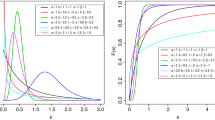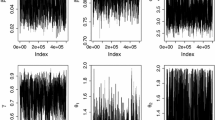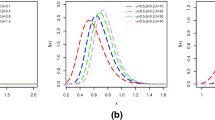Abstract
The asymmetric exponential power (AEP) family includes the symmetric exponential power distribution as a particular case. It provides flexible distributions with lighter and heavier tails compared to the normal one. The distributions of this family can successfully handle both symmetry/asymmetry and light/heavy tails simultaneously. Even more, the distributions can fit each tail separately. This provides a great flexibility when fitting experimental data. The idea of using a scale mixture of uniform representation of the AEP distribution is exploited to derive efficient Gibbs sampling algorithms in three different Bayesian contexts. Firstly, a posterior exploration is performed, where the AEP distribution is considered for the likelihood model. Secondly, a linear regression model, that uses the AEP distribution for the error variable, is developed. And finally, a binary regression model is analyzed, by using the inverse of the AEP cumulative distribution function as the link function. These three models have been built in such a way that they share some full conditional distributions to sample from their respective posterior distributions. The theoretical results are illustrated by comparing with other competing models using some previously published datasets.





Similar content being viewed by others
References
Adcock, C.J.: Asset pricing and portfolio selection based on the multivariate extended skew-Student-\(t\) distribution. Ann. Oper. Res. 176, 221–234 (2010)
Akaike, H.: Information theory and an extension of the maximum likelihood principle. In: Petrov, B.N., Csaki, F. (eds.) Proceedings of 2nd International Symposium on Information Theory, pp. 267–281. Academia Kiado, Budapest, Hungary (1973)
Albert, J., Chib, S.: Bayesian analysis of binary and polychotomous response data. J. Am. Stat. Assoc. 88(422), 669–679 (1993)
Aranda-Ordaz, F.J.: On two families of transformations to additivity for binary response data. Biometrika 68(2), 357–363 (1981)
Arellano-Valle, R.B., Bolfarine, H., Lachos, V.H.: Bayesian inference for skew-normal linear mixed model. J. Appl. Stat. 34, 663–682 (2007)
Arellano-Valle, R.B., Castro, L.M., Genton, M.G., Gómez, H.W.: Bayesian inference for shape mixtures of skewed distributions, with application to regression analysis. Bayesian Anal. 3(3), 513–540 (2008)
Arellano-Valle, R.B., Galea-Rojas, M., Iglesias, P.: Bayesian analysis in elliptical linear regression models. J. Chil. Stat. Soc. 16–17, 59–104 (1999–2000).
Arellano-Valle, R.B., Genton, M.G.: On fundamental skew distributions. J. Multivar. Anal. 96, 93–116 (2005)
Arellano-Valle, R.B., Gómez, H.W., Quintana, F.A.: Statistical inference for a general class of asymmetric distributions. J. Stat. Plan. Inference 128, 427–443 (2005)
Arnold, B.C., Beaver, R.J.: Some skewed multivariate distributions. Am. J. Math. Manag. Sci. 20(1–2), 27–38 (2000)
Ayebo, A., Kozubowski, T.J.: An asymmetric generalization of Gaussian and Laplace laws. J. Probab. Stat. Sci. 1(2), 187–210 (2004)
Azzalini, A.: A class of distribution which includes the normal ones. Scand. J. Stat. 12, 171–178 (1985)
Azzalini, A.: Further results on a class of distributions which includes the normal ones. Statistica 46, 199–208 (1986)
Azzalini, A., Dalla-Valle, A.: The multivariate skew-normal distribution. Biometrika 83(4), 715–726 (1996)
Basu, S., Mukhopadhyay, S.: Bayesian analysis of binary regression using symmetric and asymmetric links. Sankhya Indian J. Stat. 62, 372–387 (2000)
Bazán, J.L., Bolfarine, H., Branco, M.D.: A framework for skew-probit links in binary regression. Commun. Stat. Theory Methods 39, 678–697 (2010)
Blattberg, R.C., Gonedes, N.J.: A comparison of the stable and student distributions as statistical models for stock prices. J. Bus. 47(2), 244–280 (1974)
Bliss, C.: The calculation of the dosage-mortality curve. Ann. Appl. Biol. 22(1), 134–167 (1935)
Bottazzi, G., Secchi, A.: A new class of asymmetric exponential power densities with applications to economics and finance. Ind. Corp. Change 20(4), 991–1030 (2011)
Box, G.E.P.: An analysis of transformations. J. R. Stat. Soc. Ser. B (Methodological) 26(2), 211–252 (1964)
Box, G.E.P., Tiao, G.C.: A further look at robustness via Bayes’s theorem. Biometrika 49(3/4), 419–432 (1962)
Box, G.E.P., Tiao, G.C.: Bayesian Inference in Statistical Analysis. Addison-Wesley, Massachusetts (1973)
Brooks, S., Gelman, A.: General methods for monitoring convergence of iterative simulations. J. Comput. Graph. Stat. 7(4), 434–455 (1998)
Chen, M.H., Dey, D.K.: Bayesian modeling of correlated binary responses via scale mixture of multivariate normal link functions. Sankhya Indian J. Stat. Ser. A 60, 322–343 (1998)
Chen, M.H., Dey, D.K., Shao, Q.M.: A new skewed link model for dichotomous quantal response data. J. Am. Stat. Assoc. 94(448), 1172–1186 (1999)
Chib, S., Greenberg, E.: Understanding the Metropolis-Hastings algorithm. Am. Stat. 49(4), 327–335 (1995)
Collett, D.: Modelling Binary Data. Chapman & Hall, London (1991)
Cook, R.D., Weisberg, S.: An Introduction to Regression Graphics. Wiley, New York (1994)
Cox, D.R.: The Analysis of Binary Data. Methuen, London (1971)
Curtis, S.M., Ghosh, S.K.: A Bayesian approach to multicollinearity and the simultaneous selection and clustering of predictors in linear regression. J. Stat. Theory Pract. 5(4), 715–735 (2011)
Czado, C.: Parametric link modification of both tails in binary regression. Stat. Pap. 35, 189–201 (1994)
Czado, C., Santner, T.J.: The effect of link misspecification on binary regression inference. J. Stat. Plan. Inference 33(2), 213–231 (1992)
Damien, P., Wakefield, J., Walker, S.: Gibbs sampling for Bayesian non-conjugate and hierarchical models by using auxiliary variables. J. R. Stat. Soc. Ser. B 61(2), 331–344 (1999)
Delicado, P., Goria, M.N.: A small sample comparison of maximum likelihood, moments and \(l\)-moments methods for the asymmetric exponential power distribution. Comput. Stat. Data Anal. 52, 1661–1673 (2008)
DiCiccio, T.J., Monti, A.C.: Inferential aspects of the skew exponential power distribution. J. Am. Stat. Assoc. 99(466), 439–450 (2004)
Fernández, C., Osiewalski, J., Steel, M.F.J.: Modeling and inference with v-spherical distributions. J. Am. Stat. Assoc. 90(432), 1331–1340 (1995)
Fernández, C., Steel, M.F.J.: On Bayesian modeling of fat tails and skewness. J. Am. Stat. Assoc. 93(441), 359–371 (1998)
Fernández, C., Steel, M.F.J.: Multivariate Student t regression models: pitfalls and inference. Biometrika 86, 153–167 (1999)
Fernández, C., Steel, M.F.J.: Bayesian regression analysis with scale mixtures of normals. Econom. Theory 16, 80–101 (2000).
Ferreira, J.T.A.S., Steel, M.F.J.: A new class of skewed multivariate distributions with applications to regression analysis. Stat. Sin. 17, 505–529 (2007)
Gelman, A., Rubin, D.B.: Inference from iterative simulation using multiple sequences. Stat. Sci. 7(4), 457–472 (1992)
Genton, M.G.: Skew-Elliptical Distributions and Their Applications: A Journey Beyond Normality. Chapman & Hall/CRC, Boca Raton (2004)
Gilks, W.R., Richardson, S., Spiegelhalter, D.J.: Markov Chain Monte Carlo in Practice. Chapman & Hall, Boca Raton (1996)
Gómez, E., Gómez-Villegas, M.A., Marín, J.M.: A multivariate generalization of the power exponential family of distributions. Commun. Stat. Theory Methods 27(3), 589–600 (1998)
Heidelberger, P., Welch, P.: Simulation run length control in the presence of an initial transient. Oper. Res. 31, 1109–1144 (1983)
Huber, P.J.: Robust Statistics. John Wiley & Sons, New York (1981)
Jones, M.C.: In discussion of R. A. Rigby and D. M. Stasinopoulos (2005) Generalized additive models for location, scale and shape. Appl. Stat. 54(3), 507–554 (2005)
Kacperczyk, M., Damien, P., Walker, S.G.: A new class of Bayesian semi-parametric models with applications to option pricing. Quant. Financ. 13(6), 967–980 (2013)
Kim, S., Chen, M.H., Dey, D.K.: Flexible generalized \(t\)-link models for binary response data. Biometrika 95(1), 93–106 (2008)
Komunjer, I.: Asymmetric power distribution: theory and applications to risk measurement. J. Appl. Econom. 22(5), 891–921 (2007)
Lange, K.L., Little, R.J.A., Taylor, J.M.G.: Robust statistical modeling using the t distribution. J. Am. Stat. Assoc. 84(408), 881–896 (1989)
Ma, Y., Genton, M., Davidian, M.: Linear mixed effects models with flexible generalized skew-elliptical random effects. In: Genton, M.G. (ed.) Skew-Elliptical Distributions and Their Applications: A Journey Beyond Normality, pp. 339–358. Chapman and Hall/CRC, Boca Raton/Florida (2004)
MacEachern, S.N., Berliner, L.M.: Subsampling the Gibbs sampler. Am. Stat. 48(3), 188–190 (1994)
Martín, J., Pérez, C.J.: Bayesian analysis of a generalized lognormal distribution. Comput. Stat. Data Anal. 53, 1377–1387 (2009)
McCullagh, P., Nelder, J.A.: Generalized linear models, 2nd edn. Chapman & Hall, London (1989).
Monti, A.C.: A note on the estimation of the skew normal and the skew exponential power distributions. METRON Int. J. Stat. LX I (2), 205–219 (2003)
Naranjo, L., Pérez, C. J., Martín, J.: Bayesian analysis of a skewed exponential power distribution. In: Proceedings of COMPSTAT 2012, 20th International Conference on Computational Statistics, pp. 641–652 (2012).
Qin, Z.: Uniform scale mixture models with applications to Bayesian inference. Ph.D. thesis, University of Michigan (2000).
Raftery, A.E., Lewis, S.M.: How many iterations in the Gibbs sampler? In: Bernardo, J.M., Smith, A.F.M., Dawid, A.P., Berger, J.O. (eds.) Bayesian Statistics 4. Oxford University Press, New York (1992)
Sahu, S.K., Dey, D.K., Branco, M.D.: A new class of multivariate skew distributions with applications to Bayesian regression models. Can. J. Stat. 31(2), 129–150 (2003)
Schwarz, G.: Estimating the dimension of a model. Ann. Stat. 6(2), 461–464 (1978)
Smith, B.J.: boa: an R package for MCMC output convergence assessment and posterior inference. J. Stat. Softw. 21(11), 1–37 (2007)
Spiegelhalter, D., Best, N., Carlin, B., van der Linde, A.: Bayesian measures of model complexity and fit. J. R. Stat. Soc. Ser. B 64, 583–639 (2002)
Stukel, T.A.: Generalized logistic models. J. Am. Stat. Assoc. 83, 426–431 (1988)
Subbotin, M.: On the law of frecuency errors. Mathematicheskii Sbornik 31, 296–301 (1923)
Theodossiou, P.: Skewed generalized error distribution of financial assets and option pricing. SSRN Working Paper (2000).
Tiku, M.L., Tan, W.Y., Balakrishnan, N.: Robust Inference. Marcel Dekker, New York (1986)
Vianelli, S.: La misura della variabilità condizionata in uno schema generale delle curve normali di frequenza. Statistica 23, 447–474 (1963)
Walker, S.G.: The uniform power distribution. J. Appl. Stat. 26(4), 509–517 (1999)
Walker, S.G., Gutiérrez-Peña, E.: Robustifying Bayesian procedures. In: Bernardo, J.M., Berger, J.O., Dawid, A.P., Smith, A.F.M. (eds.) Bayesian Statistics 6, pp. 685–710. Oxford University Press, New York (1999)
Zellner, A.: Bayesian and non-Bayesian analysis of the regression model with multivariate Student \(t\) error terms. J. Am. Stat. Assoc. 71, 400–405 (1976)
Zhu, D., Galbraith, J.W.: A generalized asymmetric Student \(t\) distribution with application to financial econometrics. J. Econom. 157(2), 297–305 (2010)
Zhu, D., Zinde-Walsh, V.: Properties and estimation of asymmetric exponential power distribution. J. Econom. 148, 86–99 (2009)
Acknowledgments
The authors thank the editor and two anonymous referees for comments and suggestions which have improved the content and readability of the paper. This research has been partially funded by Ministerio de Economía y Competitividad, Spain (Project MTM2011-28983-C03-02), Gobierno de Extremadura, Spain (Project GRU10110), and European Union (European Regional Development Funds).
Author information
Authors and Affiliations
Corresponding author
Appendices
Appendix 1. Proofs
Proposition 1.
Proof
It is enough to show that
and so
is the pdf of the distribution \(\mathrm {AEP}(\mu ,\sigma ,\alpha ,\theta _1,\theta _2)\).
Appendix 2. Specific full conditional distributions
Equation (3):
If \(\pi (\mu )\propto 1\) this distribution becomes an uniform
If \(\pi (\mu )\) is the pdf of a normal distribution, \(\mathrm {N}(m_{\mu },s^2_{\mu }),\) the full conditional distribution becomes a truncated normal
Equation (4):
If \(\pi (\sigma )\propto 1\), the full conditional distribution of \(\sigma \) is
If \(\pi (\sigma )\propto 1/\sigma ^{m_{\sigma }}\), the full conditional distribution of \(\sigma \) is
If \(\pi (\sigma )\) is the pdf of an inverse-gamma distribution, \(\mathrm {InvGamma}(a_{\sigma },b_{\sigma })\), the full conditional distribution of \(\sigma \) is
Equation (5):
If \(\pi (\alpha )\propto 1\), the full conditional distribution of \(\alpha \) is
If \(\pi (\alpha )\) is the pdf of a beta distribution, \(\mathrm {Beta}(a_{\alpha },b_{\alpha })\), the full conditional distribution of \(\alpha \) is
Rights and permissions
About this article
Cite this article
Naranjo, L., Pérez, C.J. & Martín, J. Bayesian analysis of some models that use the asymmetric exponential power distribution. Stat Comput 25, 497–514 (2015). https://doi.org/10.1007/s11222-014-9449-1
Received:
Accepted:
Published:
Issue Date:
DOI: https://doi.org/10.1007/s11222-014-9449-1




